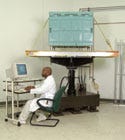Proper Product Testing Avoids Bad Vibrations
October 1, 2008
NEWS TRENDS
|
Vibration testing helps engineers ensure that product packaging can withstand force experienced in transit and in use. |
A medical product might pass through rigorous testing in-house, but if it can't survive the transportation process, the efforts made to get it to market are in vain. A process called vibration testing can help avoid this problem, but a lot of people don't understand its significance, according to a recent survey.
More than half of the 200 medical device packaging professionals who responded to a quiz conducted by DDL Inc. (Eden Prairie, MN) didn't know that vibration testing is important. Only 46% of those surveyed said they knew the test was imperative.
Vibration testing simulates the forces that occur during device transport and in the user environment. Conducted in a lab, the testing subjects a medical device to vibration frequencies and then analyzes the product's responses to the vibratory inputs.
“There's a very dynamic force involved that produces this vibration,” says Patrick Nolan, COO of DDL. “The devices that go into that environment need to withstand that kind of vibration and get to the end-user in a usable condition without being damaged.”
Nolan suspects that some packaging engineers aren't educated about how vibration is best factored into package design. “Perhaps they don't understand the inputs that occur in the distribution environment—that vibration is one of those [forces] that they need to protect [against] too,” he says. “They need to design the protective packaging to attenuate or reduce these vibration forces.”
|
Some companies don't know all of the compliance requirements related to packaging. Nolan says that DDL has been educating industry about the issue by bringing it up to speed on product-testing standards. “We're not dealing strictly with packaging engineers. We're dealing with other job titles in what it takes to develop a package and how to comply with regulations,” says Nolan.
Both of the key standards for product vibration testing involve placing the product and its components on a vibration table, where the product goes through a series of stresses, and its response is evaluated. One test is conducted horizontally and the other vertically, and they help packaging designers determine whether the packaging adequately protects the product.
The most important vibration testing standards affecting medical devices are
ASTM D3580, Standard Test Methods for Vibration (Vertical Linear Motion) Test of Products.
ASTM D5112, Standard Test Method for Vibration (Horizontal Linear Sinusoidal) Test of Products.
More information about vibration testing can be viewed on ASTM's Web site at www.astm.org. DDL also offers details about other standards that relate to the testing on its site at www.testedandproven.com/vibration_testing.html.
Copyright ©2008 Medical Device & Diagnostic Industry
About the Author(s)
You May Also Like



